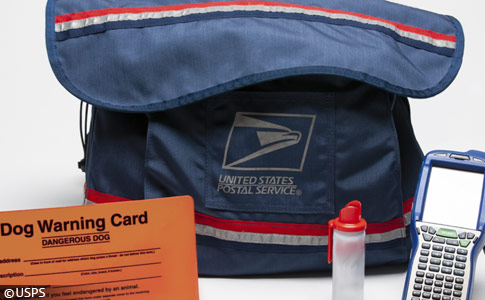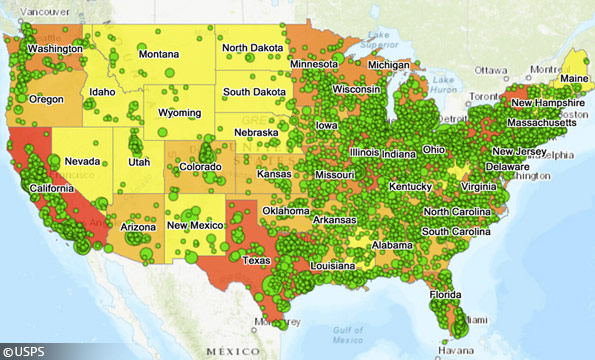Observing 2019 National Dog Bite Prevention Week®1

National Postal Service Attacks
DogsBite.org - On Sunday, the United States Postal Service kicked off their 25th National Dog Bite Prevention Week. The Postal Service was established in 1775 during the Second Continental Congress, when Benjamin Franklin was appointed the first Postmaster General. In this year's post, we briefly discuss how various special interest groups co-sponsoring the event have utilized this safety week to further their own agendas, including when the week first debuted in 1995.
We discuss the Postal Service dog attack national rankings for 2018 and how the double-digit increase of package deliveries by the USPS, including deliveries seven-days-a-week, caused a surge of attacks in 2016, the highest in three decades. We also discuss two recent high-profile maulings of mail carriers, one captured on dramatic video, and the reality that we live in an era of severe and fatal dog maulings, but few in the public sphere carry a risk as high as a letter carrier.
A History of Agenda-Ridden Co-Sponsors
Critics Outraged Over HSUS
The first National Dog Bite Prevention Week began in 1995 in a joint venture with the Humane Society of the United States (HSUS). It was a $15 million dollar campaign that included mailing a postcard to all 128 million U.S. households. This outraged HSUS critics, who stated the mailing provided the HSUS with free nationwide advertising. The postcard included the HSUS logo and its contact information to learn more "about dog bite prevention and responsible pet ownership."2
"The whole project was supposedly to prevent dog bites, but what it really does is to promote the HSUS agenda." - National Animal Interest Alliance, 1995
HSUS critics were also irate that the postcard titled, "Don't let your dog bite the hand that serves you!" contained as it's first tip: "Spay or neuter your dog -- unneutered dogs are more likely to bite!" Critics claimed the tip promoted the HSUS's agenda against "pet overpopulation," chiefly targeted at dog breeders. In 1995, this unneutered claim was supported by a single study published in 1994. Today, it is widely accepted that male castration does reduce roaming.3
According to an archive created by HSUS critics (we extracted 4 pages), Postal Service spokesman Mark Saunders said the order in which the tips appeared was random and he was unaware of any wider agenda on pets by the HSUS. "We approached the HSUS," not the other way around, Saunders said, who coordinated National Dog Bite Prevention Week in 1995 and for many years thereafter. As of 2018, Saunders was still a spokesman for the Postal Service.
AVMA & Insurance Groups
Thus began the politicking by various special interest groups behind a national week designed to promote the safety of postal carriers by reducing dog bites and attacks. By 2003, the American Veterinary Medical Association had "adopted" the event. In 2008, the AVMA received a trademark for the logo. In 2014, the AVMA received a trademark for the name and logo. So now, when the Postal Service uses the name, "National Dog Bite Prevention Week," it must be noted with an ®.
This year, the AVMA observed the national week on April 7-13. The event is listed on their Dog Bite Prevention page, which also lists their agenda items like, "Why breed-specific legislation is not the answer." State Farm, a co-sponsor of the week, boasts a more discreet anti-BSL agenda, "any dog CAN bite regardless of breed or type," along with a for-profit sales pitch, "State Farm is one of the few insurance companies in the country that does not have a breed restriction list."
The USPS National Dog Bite Prevention Week this year is April 14-20. The Postal Service describes the week in their campaign kit as, "a public service campaign that offers safety tips and emphasizes the need for increased owner responsibility" to help prevent dog attacks. "From nips and bites to vicious attacks, aggressive dog behavior poses a serious threat to our employees." Unlike animal and insurance organizations, the Postal Service has no piggybacking agenda.
Postal Service Dog Attack National Rankings
National & Local Dog Attack Data
Last year, 5,714 Postal Service employees were victimized by dogs. One gains vivid clarity of the volume of these attacks on their 2018 dog attack map. This is a decrease from 6,244 in 2017 and 6,755 in 2016, which was the highest in three decades. In 2017, the Associated Press attributed the surge of attacks to the double-digit increase of package deliveries by the USPS, including deliveries seven-days-a-week, due to agreements struck with Amazon in 2013 and 2014.
"The high for [mail carrier] attacks dated back to the 1980s, at more than 7,000, before maulings by pit bulls and other potentially aggressive dogs became a public issue." - Associated Press, April 2, 2017
Data from the Postal Service also shows that for the second year in a row, Houston led all cities in attacks on mail carriers, 75, followed by Los Angeles, 60. There were four Texas cities in the top 10 cities: Houston, Dallas, San Antonio and Fort Worth. The only other state with multiple listings in the top 10 was Ohio (Cleveland and Columbus). When looking at top states, USPS carriers in California were victimized by dogs the most (794) and nearly twice as many as in Texas (462).
Also highlighted in this year's news release is the technology the Postal Service uses to support carrier safety. The hand-held devices used by carriers to confirm customer delivery, include a feature to indicate if a dog is at an address. Secondly, the Package Pickup app asks customers to indicate if dogs are at their address when they schedule pickups, which allows USPS to send alerts to those carriers. Hopefully, technology can keep the trends of attacks moving downward.
Help Protect Your Postal Carriers
- Last year, many attacks reported by letter carriers came from dogs whose owners regularly used the phrase, "My dog won't bite."
- When a letter carrier delivers mail or packages to your front door, place your dog in a separate room and close that door before opening the front door. Dogs have been known to burst through screen doors or plate glass windows to attack visitors.
- Parents should remind children and other family members not to take mail directly from letter carriers in the presence of the family pet. The dog may view the letter carrier handing mail to a family member as a threatening gesture.
Vicious Dog Attacks Victimizing Mail Carriers
Kentucky Pit Bull Attack
On March 25, a U.S. Postal Service carrier was viciously attacked by a pit bull while on her mail route in Hopkinsville, Kentucky. USPS employee Jill Cooper was airlifted to TriStar Skyline Medical Center in Nashvillle. Debra Alexander, 54-years old, was immediately charged with harboring a vicious animal, Hopkinsville police said. The arrest citation stated, the dog "viciously attacked" Cooper and "it took two people to fight and remove the dog from the victim," reports WKRN.
A week later, local mail carrier Curtiss McColm spoke at a Hopkinsville City Council meeting. He read a letter that he prepared for the council, detailing his concerns about the hazards letter carriers face. Among them, "traffic obstacles, aggressive drivers, unsupervised children, walking obstacles and elevated risk of all these hazards when darkness falls and our ability to see is impaired. But, aggressive and vicious dogs are possibly our biggest hazard," McColm said.
Speaking on behalf of himself, not his employer, McColm also proposed several strategies to reduce these attacks, including banning pit bulls. McColm cited the Kentucky Court of Appeals decision in Bess v. Bracken County Fiscal Court, which upheld the county's pit bull ban. McColm also proposed muzzling, insurance or tethering requirements for pit bull owners and to place prioritization on animal control, especially when carriers make calls about aggressive dogs.
Debra Alexander (AKA Debra Jones and several other aliases) began a 5-year parole term on March 18, 2019, just one week before her dog violently attacked Cooper, according to the Kentucky Online Offender Look Up. She was convicted of robbery in the second-degree, a class C felony, in Christian County District Court on September 26, 2018. After the dog attack, Alexander was charged with harboring a vicious animal, which carries a fine and/or up to 60 days in jail.4
Back in February, 1-year old Ashton McGhee was killed by a family pit bull-mix while visiting his grandmother's home in Guthrie, about 35 miles from Hopkinsville. Ashton lived in Hopkinsville with his mother, Miranda McGhee. Alexander and the boy's mother are Facebook friends. Please take a moment to consider this. Alexander knows the parent of a child who was killed by a pit bull. Less than two months later, her own pit bull savagely attacked a mail carrier, requiring an airlift.
Detroit Pit Bull Attack
Also in February, a vicious attack on a Detroit mail carrier was captured on a motorist's dash cam. The six-minute video is difficult to watch. The pit bull is latched onto the carrier's foot, while the male carrier is lying on the side of a residential street (a scene not too different than an image released this year by the USPS for National Dog Bite Prevention Week). The man inside the vehicle is distressed and honking the horn, as a woman holding a broom tries to help the carrier.
A man wearing a red hat gets out of the vehicle and hurls a trashcan at the pit bull then beats the dog with a "Club." All the while, the carrier is screaming, still on the ground with the pit bull latched onto his foot. At 3 minutes, a person appears with a leash. By 4 minutes, they have extracted the dog from the carrier. By 4:22, the pit bull is loose again, but appears injured. Then a car door slams. "Thank you," says the mail carrier to the man in the red hat, now safely inside his car.
But the pit bull is not finished. Next, it goes after the woman who had been carrying the broom. The man wearing the red hat shouts, "Get in the house!" The camera gets flipped upside down and honking is heard. "Get her in the house, NOW!" he yells again. By 5:40, the camera is righted and the man in the red hat is back inside his car with the carrier. He considers moving his car before calling 911 then realizes, "You're the government bro (USPS) -- I'm calling right now."
The unnamed owner of the pit bull told WXZY, "I used to tease and say, 'Oh you know he's a little push over -- he wouldn't bite anybody.'"
After the video went viral, Detroit media reported the attack happened in the 20000 block of Ardmore Street on February 22. The letter carrier was reported to be in stable condition, but the pit bull was able to bite through his boot. At one point, the pit bull is seen latched onto the carrier's forearm and hand as well. The USPS released a statement thanking all of the people who helped the carrier. Detroit Animal Care and Control took the pit bull, named "Boss Hog," into custody.
On April 15, in alliance with 2019 Dog Bite Prevention Week, the victim of the Detroit pit bull mauling, postal carrier Todd Bridges spoke for the first time publicly. "I turn around, I see a pit bull charging at me in full force," Bridges said. "Each day I try to push it further and further back into my mind. I try not to do anything that is going to trigger it." Bridges said he unleashed his entire canister of dog spray on the pit bull. "I sprayed in his face, eyes and his mouth," Bridges said. "It's like it didn't even phase him." Oneil Colley was also at the public awareness event today, where he was presented with a Hero Award. - ClickOnDetroit, April 15, 2019
Summary & Call to Action
With a double-digit increase of package deliveries by the Postal Service, including deliveries seven-days-a-week, we remind all dog owners to be vigilant in your efforts to ensure the safety of your Postal Service carriers, as well as your UPS and FedEx carriers. All dogs are territorial and present a biting risk to these employees. If you are using the mobile USPS Package Pickup application (or website application), please let them know if there is a dog at your location.
For future observation of National Dog Bite Prevention Week, our nonprofit will only observe the week that is steered by the Postal Service, an entity that has no other agenda than to protect their employees and to remind dog owners that vigilance is needed to prevent bites and attacks. "Boss Hog," unsurprisingly, shot out of his home when the owner's nephew tried to leave. The hero in the red hat, Oneil Colley, drove up to the scene while the vicious attack was already in progress.
As the 2017 Associated Press article noted, "The high for [mail carrier] attacks dated back to the 1980s, at more than 7,000, before maulings by pit bulls and other potentially aggressive dogs became a public issue." These maulings are now a larger public issue than ever, but few in the public sphere carry a risk as high as a letter carrier. Remember what mail carrier Curtiss McColm said at the city council meeting, "aggressive and vicious dogs are possibly our biggest hazard."

National map showing the 5,714 dog attacks on U.S. Postal Service carriers in 2018.

Oneil Colley seen with postal carrier Todd Bridge on March 29, one month after rescuing him.
2We believe the extracted archive is mainly from a July-August 1995 NAIA newsletter, as is referenced in the piece ("Dog Bite Prevention Campaign Pairs Post Office with Animal Rights Organization," NAIA News, July-August 1995). The NAIA website dates back to 1997, so we could not find this specific newsletter source. It's certainly believable the NAIA would have taken this stance in 1995. This all occurred over two decades ago, when the spay/neutering message to the public was still being villafied. It's a rather fascinating piece of history!
3Surprisingly, little research has been done in this area. Which Dogs Bite? A Case Control Study of Risk Factors, was published in 1994. It was based on 1991 Denver County dog bite data, thus pit bull behavior was excluded since Denver banned pit bulls in 1989. The study concluded that dogs most likely to bite were "male, unneutered and chained." In 1997, the Effects of Castration on Problem Behaviors in Male Dogs with Reference to Age and Duration of Behavior, by Neilson et al., found that sterilizing males was "most effective in altering objectionable urine making, mounting, and roaming." Some aggressive behaviors were curbed in a fewer than one-third of the dogs.
4Sections 258.235 and 258.990 of the Kentucky Revised Statutes (KRS).
Related website pages:

Of course the best way to keep anyone from getting attacked is don’t get a breed know for attacking people unprovoked.
I second that.
Another deep irony is that at the time, the HSUS had a much more realistic view of pit bulls and advanced the completely rational view of supporting certain types of BSL and discouraging shelters from adopting out dogs confiscated from dogfighting rings.
The NAIA was formed to fight the animal advocacy movement and supported “owner’s rights” and the rights of animal-using industries to conduct their business unimpeded.
Now we have the HSUS, Best Friends, et. al., basically working as lobbying arms for pit bull breeders, and the right of them to conduct their business unimpeded–undoing so much of the hard work to reduce the number of unwanted pets that are born only to be abandoned or euthanized. It’s so depressing. Merritt Clifton has written extensively on it.
All the more reason to stop donating money to these organizations.
I’ve started returning their requests for donations with a message to the effect of “until you stop promoting pit bulls as a pet, you won’t get another dime from me”.